
Manicured grounds, Riviera Cultural Center

Unique architecture

Entrance of the "Centro Cultural Riviera"

Given by cities of Pulandia and
Dalian in Liaoning Province, China

Cuauhtemoc, last Aztec leader
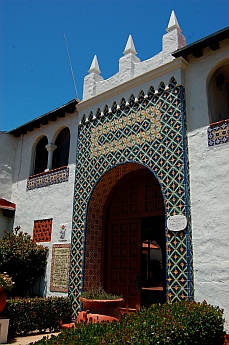
Arched entrance.

Hallway of arches.
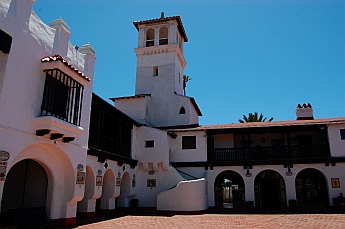
Back courtyard makes the rest of Ensenada seem
worlds away.


The Margarita was invented here
in 1948...

Bar Andaluz

Classical guitar and flute concert.

Local politicians get the word out before elections.

Terrible Herbst's Prevost in the marina parking lot.

Mechanics tweek the race machines.
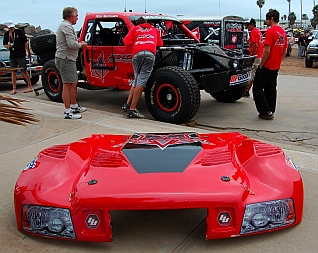
Hoods off -- all the way off!

Team McMillin sets up shop next door.

Vehicle parade before the inspections.

Race vehicles come in all shapes and sizes.
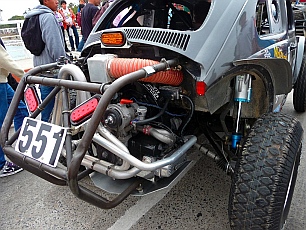
A souped up VW bug that Mark really liked.
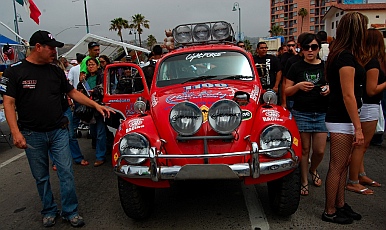
The throngs were so thick the race cars had to creep past.

Drivers give autographs.
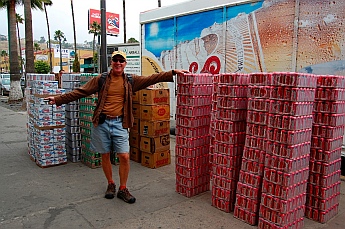
Beer for all.

The Baja 500 is a testosterone fest.
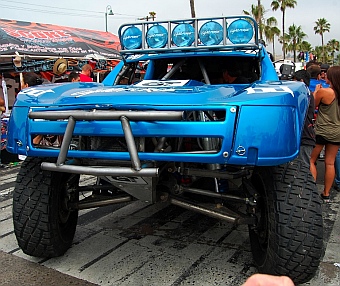

An all women's team.
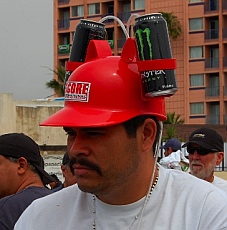
Wacky hats were the norm.
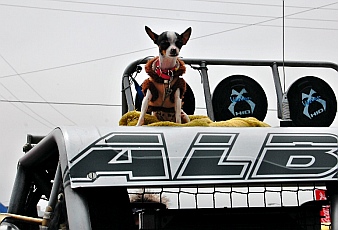
A chihuahua was one team's mascot.

But I only had1 beer, officer...

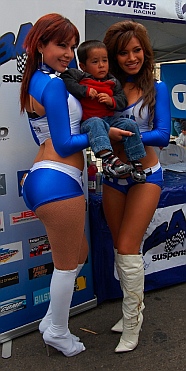
Everyone posed with the hot
promo gals, no matter how
young or old.
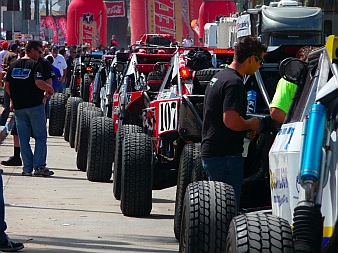

The scene before a lightning fast racer sped past.
Riviera Cultural Center & Baja 500 Race
June, 2010 - Now into our fifth of six months in Ensenada, we took a
break from the local tourist scene and began to zero in on final boat-
related projects to prepare Groovy for cruising. Our major project was to
install an arch support for three large 24-volt solar panels. This involved
shipping parts to San Diego, picking them up and hauling them here in
our truck, as well as having a local stainless steel expert design and build
the arch support. Not a trivial project.
So it came as welcome relief
when our new Australian friends
who had come through the
marina on their way south in April
returned to Ensenada once again
on their way north. As we
watched their videos of leaping dolphins and exotic rock formations in the more remote
parts of the Sea of Cortez, our appetites were whetted for upcoming Groovy
adventures, making all that work on our solar charging system seem very worthwhile.
At the same time, we had a chance to show them one of our newest Ensenada
discoveries: the Riviera Cultural Center.
This special spot in town is
impossible to miss, as it is
a huge, white, ornate
building with many wings
right on the main drag. The architecture is grand and historic
looking, and the grounds are meticulously maintained. However,
it was not obvious to me that the building was open to the public.
Two lions guard one
entrance, gifts to Ensenada
in a spirit of brotherhood by
the cities of Pulandia and
Dalian in Liaoning Province,
China.
A statue of the last leader of the Aztecs,
Cuauhtemoc, graces another part of the front lawn
of the Riviera. Cuauhtemoc ruled Tenochtitlan
from 1520-21 before it fell to the Spanish and was
rebuilt as Mexico City. His name alludes to an
eagle diving for its prey, in reference to his
determination and aggressiveness. Assuming
leadership at just 18, probably no amount of
determination, youth or aggression could have
stopped the Spanish from decimating the Aztecs.
When he would not reveal where the (nonexistent)
gold treasure was hidden, he was tortured by
having his feet put to fire. He died at 25 when
Cortez deceived him and had him killed.
On a lighter note, the Riviera is a beautiful and
unique property. The cultural center hosts a wide
variety of events all year long, and there is an art
gallery at one end. But perhaps its best feature is
the famed Bar Andaluz which not only makes the
best Margaritas in town, but claims to be where the
Margarita was first invented.
After walking through the prettily landscaped
grounds, you pass through an arched entrance into
a wooden ceilinged hallway of arches.
From there you emerge out into a back open air
courtyard of lined with more arches. The walls are
decorated with tiled images of all kinds. Many tiles
depict various mission churches that are located
throughout Mexico. Each mission tile painting is
accompanied with a quote from a famous thinker,
ranging from Confucius to Francisco de Quevedo
(a 17th century Spanish writer) to John F. Kennedy.
The decorative tiles also tell the
building's history. First opened
as the Riviera Hotel and Casino
in 1930, it was occupied by the
Mexican military in 1941-42. In
1948 it came under the proprietorship of one Señora Margarita Plant.
After the "Golden Age" of the 1950's, the hotel changed hands several
times and was renovated as a cultural center in 1990. Back in 1948,
the fussy Sra. Margarita Plant wanted a tasty drink but disliked the
flavor of Mexico's native libation, tequila. So she asked her bartender,
David Negrete, to create a special drink for her. Combining the tequila
with lime juice and Controy (a
Mexican orange liqueur like
Triple Sec, Cointreau or Grand
Marnier), and rimming the glass
with salt, the Margarita was born.
Looking online for a little more info on the history of the Margarita, I discovered the
drink is attributed to several possible inventors, but Sr. Negrete in Ensenada, Mexico is
definitely a front runner. Interestingly, most English language histories list this
bartender as "Daniel" Negrete, not "David," while in
Spanish they all point to "David" Negrete.
The bar is small but cozy, and the back wall is
covered with a dramatic mural depicting all kinds of
Spanish icons, including a lovely Flamenco dancer.
The Margaritas are truly the best
I've ever had, made with lime
juice so fresh it is squeezed into
your glass. We returned yet
another night to watch a free
classical guitar concert put on by
local university students.
Ensenada boasts five universities
in and around town, and the bar
room was packed with university
people. As we sat
there listening to
guitar and flute
duets by Bach, I
felt that we had discovered yet another side to Ensenada, one that has
nothing to do with the tourist party scene or the boating, biking and off-road
racing scene. Our musical evening at the Riviera was enchanting.
Back out on Gringo
Gulch one day, we
heard a commotion
ahead and saw an
open air double
decker bus coming
towards us beeping
its horn loudly. It was
decorated with posters and filled with people wearing matching hats and
waving flags. As they went by we realized it was a local politician out
campaigning, Mexican style, for the upcoming elections.
Not long after that, the Baja 500 Boys showed up in the Hotel
Coral & Marina parking lot for their annual 500 mile off-road
race through the desert. In just hours the marina parking lot
was transformed from a ho-hum dirt lot partially filled with
boaters' cars to a high intensity, high profile, home base for
the two major teams that were in contention for overall race
honors this year.
We watched in awe as the two million dollar Prevost motorhomes owned
by Terrible Herbst (the same folks who own the Terrible's casino and
convenience store chains in Nevada), circled each other in the parking
lot and made space between them for coolers, barbecues and camp
chairs, not to mention exotic race cars and mechanics to work on them.
Hoods went up, wheels came off, and many pairs of hands reached into
the bellies of these vehicles to tweak them to max power.
Just moments later
the McMillin team
appeared and set up
a large tent for their
racing fleet and
mechanical wizards.
I knew we were in the
presence of the titans
of this sport when one
fellow I'd been talking
to suddenly told me in
hushed tones, "See
that guy over there in
the blue ballcap
looking at that
engine? His
name's Larry
Roeseler and he
won the Baja 1000
a bunch of times."
But this visiting crowd of desert speedsters weren't the only new kids on
the block. As I looked around at my cruising friends who had joined us
in the parking lot, I suddenly I saw them metamorphose. Men whom I'd
known only as sailors outfitting their boats with Single Sideband Radios
and heavy duty ground tackle while comparing notes on how to read
the weather offshore, suddenly began to ooh and aah over custom
steering linkages, big lobe cams and long travel suspensions.
Throughout the week leading up to the race we heard the rumbling
thunder of race cars coming and going from the hotel all day and
seemingly all night too. A small portion of the racetrack was open
for practice runs, and the teams took full advantage. The gates
leading out of the marina hotel are on an uphill, and the drivers
would rev the engines to max volume in salute to their friends each
time they left through those gates.
The Baja 500 is definitely a testosterone fest. The day before
the race all the vehicles (cars, trucks, buggies and motorcycles)
paraded through town on their way to the inspection area. The
crowd was so thick you had to bump your way through to get
anywhere. People hung over the cars, patting them, posing
their kids in front of them for photos, and asking the drivers for
autographs.
Beer was stacked in front of every bar in anticipation of a rowdy
weekend, and the all the sponsors brought the hottest gals they could
find. All the vehicles were exotic looking, tricked out to the max and
ready to take on the challenging dirt roads of the desert.
Checking out a friend's
photos from the Baja 500 on
his cell phone a few days
later confirmed my suspicion
that the guys there took as
many photos of the leggy,
scantily dressed promo gals
as they did of the cars. They
were everywhere, and they
posed with everyone, from
tyke to teen to grandpa.
One all pink race car bore the
license plate "Alotta" (in
reference to the first name of
Austin Powers' hottie?) while
lots of folks paraded around
in crazy hats and getups.
One of the race cars
had a chihuahua atop
as a mascot, and Mark
found a Tecate can he
couldn't quite lift.
The race featured 289 entrants from 26
states and 13 countries. Starting in
Ensenada, the course took a loop through
the interior of the northern Baja peninsula,
returning to town after 438+ miles. The
motorcycles left at 6:00 a.m. followed by
the four wheeled vehicles in various
categories a little later.
I had hurt my knee so I decided
not go to the race start, but Mark
put his camera into video mode so
I wouldn't miss a thing.
Unfortunately, he didn't check the
camera settings before he started
shooting. When he sat down to
show me his very cool videos, all
he had were still images of the
empty track before and after each
car zoomed pass. Oh well. He
said it was truly awesome, rockets
on wheels flying by in thunderous
clouds of dust.
The first motorcycles could be
heard screaming back to town a
few hours after lunch, while the first
four wheelers didn't get back until
dinnertime. Slower buggies and
trucks could be heard roaring
across the finish line in town all
night long.
Walking by the McMillin tent near
sunset we suddenly heard their
radios crackle to life with chatter.
Their car had just won the main
event of the race. Drivers Scott
and Andy McMillin, father and son, are the 2nd and 3rd generation of desert drivers in this
legendary racing family. They finished in just over 9 hours, averaging 47+ mph. When
the pair returned to the hotel, we heard the distinct roar of their triumphant, tricked out
850 hp Ford 150 truck as it took a noisy victory lap down through the entrance gates and
into the marina parking lot.
The next few weeks found us in constant motion as we ticked down our "to do" list of boat
projects that we wanted to finish before leaving the luxury of Hotel Coral & Marina. But
friends finally swept us away to a delightful day
Find Ensenada on Mexico Maps.
